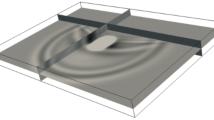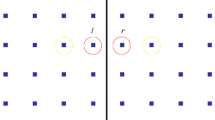Abstract
Heterogeneous media with fractured geological structures are widely spread, and therefore, they need a very careful exploration. In this work, we present the results of modeling the seismic waves spread through the homogeneous and heterogeneous media with single fractures and fracture clusters using the grid-characteristic method. We analyze the seismic reflections from inclined fractured structures described by the model of a two shore extremely thin fracture. The models with little differing and significantly differing characteristics for single fluid- and gas-filled fractures and fracture clusters are analyzed. The results demonstrate the dependence of the normal components of the velocity distribution from the media parameters.
Access this chapter
Tax calculation will be finalised at checkout
Purchases are for personal use only
Similar content being viewed by others
References
Schoenberg, M.: Elastic wave behavior across linear slip interfaces. J. Acoust. Soc. Am. 68(5), 1516–1521 (1980)
Hudson, J.A.: Overall properties of a cracked solid. Math Proc Cambridge Philos. Soc. 88, 371–384 (1980)
Nikitin, I.S., Burago, N.G., Golubev, V.I., Nikitin, A.D.: Mathematical modeling of the dynamics of layered and block media with nonlinear contact conditions on supercomputers. J. Phys. Conf. Ser. 1392, 012057.1–012057.6 (2019)
Muratov, M.V., Petrov, I.B.: Application of mathematical fracture models to simulation of exploration seismology problems by the grid-characteristic method. Compu. Res. Model. 11(6), 1077–1082 (2019)
Zhan, Q., Sun, Q., Ren, Q.: A discontinuous Galerkin method for simulating the effects of arbitrary discrete fractures on elastic wave propagation. Geophys. J. Int. 210(2), 1219–1230 (2017)
Khokhlov, N., Stognii, P.: Novel approach to modeling the seismic waves in the areas with complex fractured geological structures. Minerals 10(2), 122.1–122.17 (2020)
Ivanov, A.M., Khokhlov, N.I.: Efficient inter-process communication in parallel implementation of grid-characteristic method. In: Petrov, I., Favorskaya, A. (eds.) Smart Modeling for Engineering Systems. GCM50 2018. Smart Innovation, SIST, vol. 133, pp. 91–102. Springer, Cham (2019)
Savin, G.N., Rushchitskii, Y.Y., Novatskii, V.: The theory of elasticity. Sov. Appl. Math. 7, 808–811 (in Russian) (1971)
Ivanov, A.M., Khokhlov, N.I.: Parallel implementation of the grid-characteristic method in the case of explicit contact boundaries. Comput. Res. Model. 10(5), 667–678 (2018)
Cerquaglia, M.L., Deliege, G., Boman, R., Terrapon, V., Ponthot, J.-P.: Free-slip boundary conditions for simulating free-surface incompressible flows through the particle finite element method. Int. J. Numer. Meth. Eng. 110(10), 921–946 (2017)
Huang, L.-J., Mora, P., Fehler, M.C.: Absorbing boundary and free-surface conditions in the phononic lattice solid by interpolation. Geophys. J. Int. 140(1), 147–157 (2000)
Muratov, M., Petrov, I., Leviant, V.: Grid-characteristic method as optimal tool of fracture formations research. In: European Association of Geoscientists & Engineers. Conference Proceedings, vol. 2018, pp. 1–6. Saint Petersburg (2018)
Petrov, I.B., Muratov, M.V.: The application of grid-characteristic method in solution of fractured formations exploration seismology direct problems (review article). Matem. Mod. 31(4), 33–56 (2019)
Muratov, M.V., Petrov, I.B., Levyant, V.B.: The development of fracture mathematical models for numerical solution of exploration seismology problems with the use of grid-characteristic method. Comput. Res. Model. 8(6), 911–925 (2016)
Acknowledgements
The reported study was funded by RFBR according to the research project № 18-01-00710 A.
Author information
Authors and Affiliations
Corresponding author
Editor information
Editors and Affiliations
Rights and permissions
Copyright information
© 2021 The Author(s), under exclusive license to Springer Nature Singapore Pte Ltd.
About this paper
Cite this paper
Stognii, P.V., Khokhlov, N.I. (2021). Investigation of Models with Fluid- and Gas-Filled Fractures with the Help of the Grid-Characteristic Method. In: Favorskaya, M.N., Favorskaya, A.V., Petrov, I.B., Jain, L.C. (eds) Smart Modelling For Engineering Systems. Smart Innovation, Systems and Technologies, vol 214. Springer, Singapore. https://doi.org/10.1007/978-981-33-4709-0_11
Download citation
DOI: https://doi.org/10.1007/978-981-33-4709-0_11
Published:
Publisher Name: Springer, Singapore
Print ISBN: 978-981-33-4708-3
Online ISBN: 978-981-33-4709-0
eBook Packages: Intelligent Technologies and RoboticsIntelligent Technologies and Robotics (R0)




